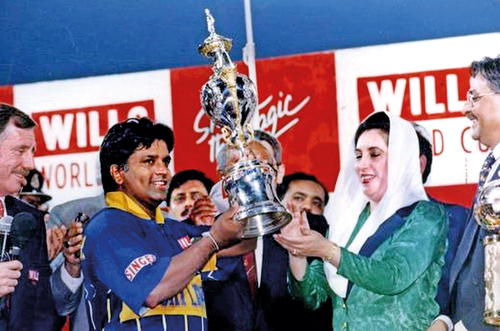Road to Lahore for the Wills World Cup
View(s):
When Sri Lanka won the World Cup
This week, many Sri Lankans remembered the 25th anniversary of winning the Wills Cricket World Cup by the Sri Lankan cricket team on March 17, 1996. The winning match was played against Australia at the Gaddafi stadium in Lahore, Pakistan. It was attended by over 60,000 cricket fans, mostly from Pakistan, who cheered for a Sri Lankan victory.
The journey to the finals was full of exciting events and circumstances. The two teams had their first match of the tournament scheduled in Colombo, and Sri Lanka was awaiting to welcome Australia. However, Australia, which was once a world cup winner, had no reason to take Sri Lanka seriously. Unlike Australia, Sri Lanka had never been such a world cup winner before. By refusing to visit Sri Lanka on security reasons, they even decided to throw away two points freely; the West Indies joined them too and offered another two points to the embarrassment of Sri Lanka.
Twist of fate
Here came the semi-finals. Sri Lanka played against India at Eden Gardens in Kolkata. The crowed became furious after realizing that the Indian team was losing; they started rioting in the pavilion by throwing bottles and metals as well as firecrackers to the players, disrupting the match; finally, the match was abandoned and Sri Lanka was awarded it by default.
At the other end, the semi-finals were played by Australia and the West Indies – the two teams which initially stood together to decide not to come to Sri Lanka. Alas; it was a twist of fate that now they had to fight each other to become qualified in order to face Sri Lanka at the finals. And it was Australia which was qualified and faced Sri Lanka at the Gaddafi stadium in Lahore.
Cricket or the so-called “boys’ game” which was born in England a couple of centuries ago, was picked up by other nations from the Englishmen who travelled across the world, occupying and colonizing these lands. The same boys’ game is now played by these nations too equally competing with its original owners or even performing better than them.
Since the time after winning the Wills Cricket World Cup, however, a couple of times Sri Lanka came close to the finals and semi-finals; but it never won the World Cup again during the past 25 years. The analysts and commentators might be having different opinions about the ups and downs. Even in the face of all that, however, the Sri Lankan cricket continued to remain in the international arena although its international competitiveness seems to have been challenged.
Here is its economics
There is cricket almost everywhere in the country – from post-harvest paddy fields to the street corners of the localities. Had our players of the national cricket team played cricket only in the paddy fields and the street corners, they would have never been exposed to international cricket. They would have never played with international cricketers and, in fact, they would have never come even to think of winning a world cup tournament.
There is a big difference between playing “local cricket” and playing “international cricket”. When children play cricket in the paddy fields or street corners, it is understood and accepted that the pitch is sub-standard, and the logistics are mediocre. Rules can be twisted, and the tools may be proxies. Techniques are inferior and technologies are ordinary. There may be talents and skills, but they don’t grow beyond these local boundaries to form world-class capabilities. Spectators too do not expect anything at higher quality, because their demand is conditioned by the local environment in the paddy fields or the street corners. But everyone can be happy within their local environments.
 You may see the exact opposite of conditions and circumstances when international cricket is played. There is no game when the players are not up to the international standards and competitive to stand against their competitors. The techniques and technologies should be world-class, while rules of the game should remain intact. The infrastructure, the pitch, the logistics and everything of the physical environment have to be at international standards. Talents and skills are worthy, but these things need to be sharpened and disciplined. The demand of the spectators is international too so that the sub-standard performance cannot survive too long in an international environment.
You may see the exact opposite of conditions and circumstances when international cricket is played. There is no game when the players are not up to the international standards and competitive to stand against their competitors. The techniques and technologies should be world-class, while rules of the game should remain intact. The infrastructure, the pitch, the logistics and everything of the physical environment have to be at international standards. Talents and skills are worthy, but these things need to be sharpened and disciplined. The demand of the spectators is international too so that the sub-standard performance cannot survive too long in an international environment.
International markets
If we choose any economic activity that has progressed and flourished in international markets, they perform like playing international cricket. It doesn’t matter whether they are sold to the local customers or international customers, the products are competitive globally in terms of cost and quality. If the cost is not competitive and the quality is sub-standard, then the market for such products may not survive for too long; the competitive products will soon overtake it.
In order to make the products internationally competitive in terms of cost and quality, the inputs – both primary inputs such as capital, labour and technology, and secondary inputs such as materials, parts, components and utilities, have to be competitive too. Therefore, only efficient economic activities may survive in an international market environment.
The economic activities that are reluctant to face international competitiveness prefer themselves to be confined to the local markets. They may even prefer protecting their market using trade barriers which would guarantee their profits. Unless and until they achieve international competitiveness and face international competition, it would be difficult for them to become global winners.
While it is not unusual to observe that international players demand an open environment, local players demand a closed-door environment. As all inputs are not available within the local environment, however, both types of players prefer inputs without protective barriers. Here is the dilemma of the local players; they need their output to be protected, but inputs to be free, which leads to other complications.
Here is the dilemma for policy makers; these inputs cannot be made available free from protection, if they are produced by some other local players as well. Then, should we protect them or not? And we need to go by a product by product basis covering thousands of products in identifying which ones for protection and which ones for free trade; anyway, it would never solve the resulting administrative complications!
Sometimes, we find the strategies directed at conquering the international market on the one hand, and at protecting the local market on the other hand. If we are attempting to establish such a half-and-half policy regime, here is our hypocrisy: Others should open their markets for us, but we should keep ours closed for them.
Team mentality and fan mentality
We might be able to see two types of attitudes in cricket tournaments or any other game alike; team mentality and fan mentality. We saw both were overwhelming in the road to Lahore aimed at winning the Wills World Cup as well.
A team should stay in one accord whether it is winning time or losing time, which is the team mentality; we have seen it throughout the entire journey of the Sri Lankan team to win the world cup. In general, the teams perform with team mentality. In contrast, fan mentality is commonly found among the spectators who would tend to be switching between cheering and jeering. They cheer when the team is winning and jeer when the team is losing.
A nation is a team and should work with team mentality on the road to prosperity. If a nation is divided into segments and work with fan mentality, it would be difficult to progress and achieve prosperity.
(The writer is a Professor of Economics at the University of Colombo and can be reached at sirimal@econ.cmb.ac.lk and follow on Twitter @SirimalAshoka).



